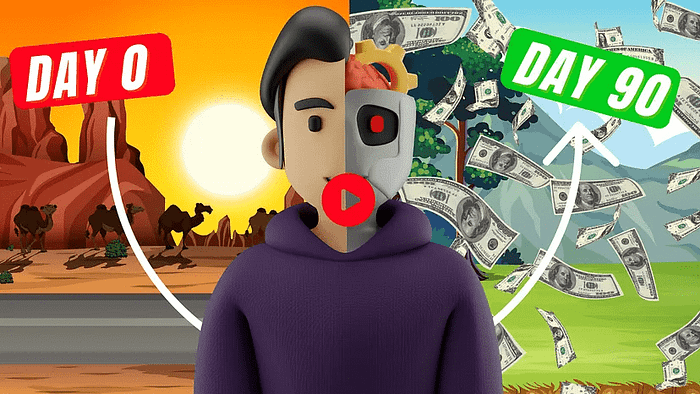How Twenty-Two Failed Ventures Led to Building a Multi-Billion Dollar Security Empire
In the competitive landscape of Silicon Valley, where success stories often overshadow the grinding reality of entrepreneurial struggles, emerges an extraordinary narrative of resilience. This isn’t a tale of overnight triumph or privileged connections – it’s a raw, authentic journey of someone who failed repeatedly, learned continuously, and ultimately transformed those lessons into a $2.5 billion security company that’s reshaping the industry landscape.
We strongly recommend that you check out our guide on how to take advantage of AI in today’s passive income economy.
Table of Contents
The Courage to Leave Comfort Behind
The story begins in the prestigious halls of Union Square Ventures (USV), where many would consider themselves fortunate to land a position. Despite having what appeared to be an ideal career trajectory in venture capital, an undeniable pull toward creation and innovation sparked a decision that many considered foolish. The choice to leave USV wasn’t just about pursuing entrepreneurship; it represented a fundamental belief that failed attempts at creation held more value than successful execution of others’ visions.
The departure came with its share of skeptics. Colleagues pointed out the power of the USV email domain, suggesting that sacrificing such institutional backing was a failed strategy from the start. However, this decision embodied a deeper understanding that true innovation often requires stepping away from the safety of established institutions.
The Systematic Approach to Failed Projects
The subsequent two years marked a period of intense experimentation and what appeared to be continuous failure. Each morning began with a structured routine – dressing professionally and walking to a shared workspace, maintaining the discipline of a traditional job while pursuing unconventional goals. This period saw the development of numerous projects, each representing a failed attempt at market penetration but a successful step in the learning process.
The projects ranged widely in scope and ambition. A book recommendation platform emerged from a personal passion for literature, while a voice assistant for biologists attempted to bridge technology and science. Each failed venture contributed to a growing understanding of market dynamics and product development. The key wasn’t in avoiding failure but in learning to fail productively.
The Psychology of Persistence
Managing personal psychology became a crucial element of the journey. A weekly self-assessment routine emerged, built around a Google Form that asked pointed questions about progress, goals, and potential stopping points. This systematic approach to evaluating failed projects prevented the common entrepreneurial trap of emotional attachment to failing ideas.
The psychological framework extended beyond project evaluation. Core habits, such as regular reading and running, became anchors of stability during turbulent times. These practices weren’t just about personal wellness; they represented a deeper understanding that sustained innovation requires a balanced mind capable of weathering repeated failure.
The Market Revelation
The breakthrough came through an unexpected channel – experiencing the complexities of security compliance while working at Dropbox. This position, taken after numerous failed ventures, provided crucial insight into a significant market gap. While large companies maintained dedicated security teams, smaller startups struggled with increasingly complex compliance requirements.
This observation led to a fundamentally different approach to product development. Rather than rushing to code another potentially failed solution, validation came through simple tools – initially just an Excel spreadsheet. This methodology, born from previous failed attempts, proved crucial to the company’s eventual success.
Building with Purpose and Precision
The security company emerged not just from technical capability but from a deep understanding of market needs. Previous failed ventures had taught the valuable lesson that technical excellence alone doesn’t guarantee success. The focus shifted to solving real problems for real customers, with every feature and function tied to genuine market requirements.
The growth strategy deliberately deviated from conventional startup wisdom. While many companies rush to raise venture capital, this venture grew to $10 million in annual recurring revenue before seeking significant funding. This patient approach, while potentially appearing as a failed traditional strategy, proved highly effective in building sustainable value.
The Culture of Excellence
As the company scaled, maintaining high standards became a defining characteristic. Rather than accepting industry norms, which might have represented failed approaches to quality and service, the organization set unprecedented benchmarks for performance. This commitment to excellence extended from customer service to internal operations, creating a culture where exceptional performance became the standard.
The approach to team building reflected lessons learned from failed previous ventures. Rather than rushing to hire, the focus remained on finding individuals who shared a commitment to excellence and continuous improvement. This selective approach to growth, while slower, ensured the maintenance of high standards throughout the organization.
Innovation Through Understanding
The security platform’s success emerged from a deep understanding of customer needs rather than just technical capabilities. Having failed at building products nobody wanted, the focus shifted to solving real problems for real customers. This approach resonated strongly with the market, leading to organic growth through word-of-mouth and strong customer advocacy.
The development process incorporated lessons from every failed previous attempt. Each feature and function underwent rigorous validation before implementation, ensuring that development efforts aligned with genuine market needs. This methodical approach, while potentially slower than rapid development cycles, ensured that resources focused on creating genuine value.
The Power of Patient Growth
The company’s expansion required maintaining high standards while scaling rapidly. Rather than accepting industry norms, which might have represented failed approaches to quality and service, the organization set unprecedented benchmarks for performance. This attention to detail and quality became a key differentiator in the market.
Marketing strategies evolved from deep understanding of customer needs. Rather than traditional aggressive outreach, the focus remained on building genuine connections within the startup community. This approach, while potentially appearing as a failed traditional marketing strategy, proved highly effective in building sustainable growth.
Looking Forward While Learning from the Past
Today, the company stands as a testament to the value of perseverance through failed attempts. The journey from failed projects to building a multi-billion dollar enterprise offers profound insights into the nature of innovation and entrepreneurship. Success emerged not from avoiding failure but from learning to fail productively and maintaining unwavering standards throughout the growth process.
The future holds continued challenges and opportunities. The security landscape continues to evolve, requiring constant innovation and adaptation. However, the lessons learned from previous failed ventures provide a strong foundation for navigating these challenges while maintaining commitment to excellence and customer value.
Conclusion: The Value of Failed Attempts
The transformation from repeated failed ventures to building a $2.5 billion security company demonstrates the profound value of persistence, learning, and adaptation. This journey proves that what appears to be a failed attempt can become the foundation for extraordinary success when combined with the right mindset and methodology.
In the dynamic world of entrepreneurship, failure isn’t just an acceptable outcome – it’s often a necessary step toward eventual success. This story stands as a powerful reminder that innovation requires courage, persistence, and the wisdom to learn from every failed attempt. The path to extraordinary success often winds through the valuable territory of productive failure.

We strongly recommend that you check out our guide on how to take advantage of AI in today’s passive income economy.




